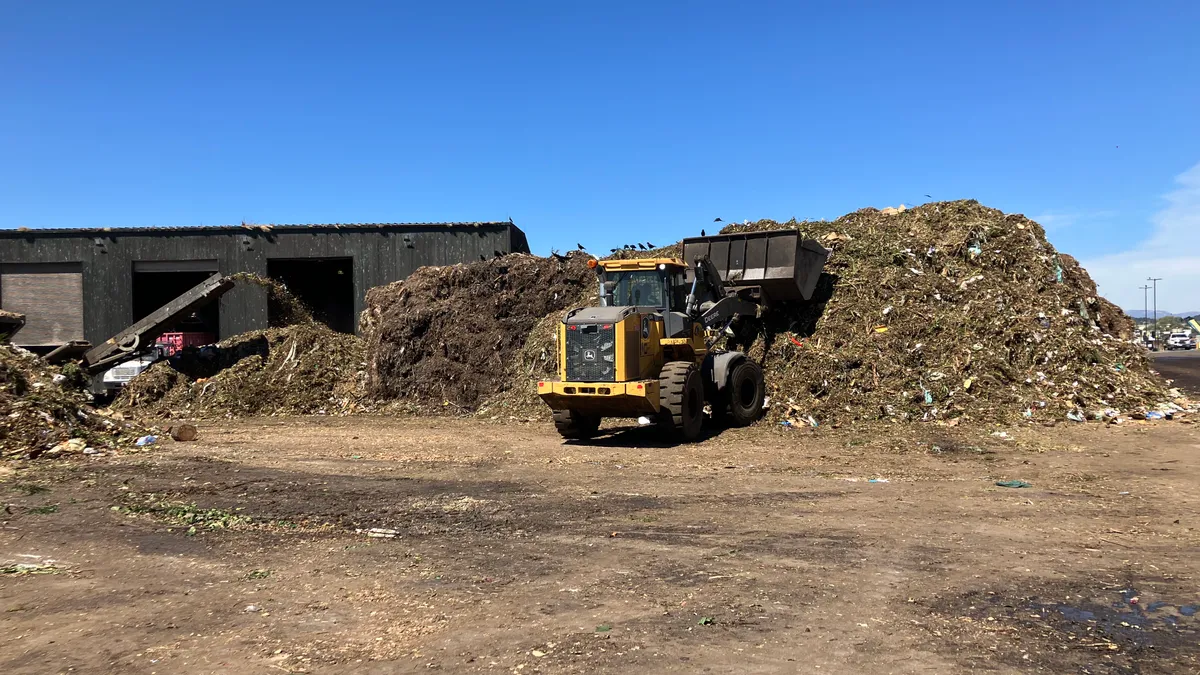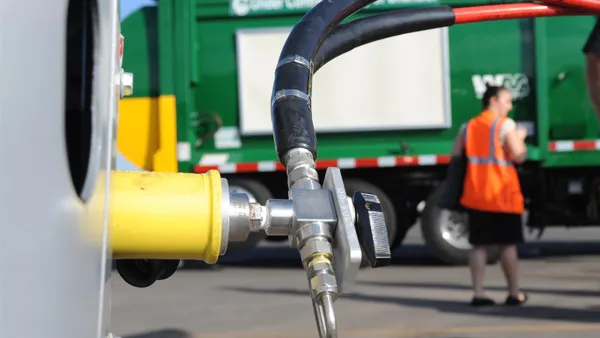Earlier this month, over 200 composters, packaging manufacturers and others gathered in Berkeley, Calif., to talk about the future of organics recycling at the second annual BPI Summit. When it comes to what’s next for compostable packaging, the future is about as clear as compost leachate.
For well over a decade, composters who sell U.S. Department of Agriculture-certified organic compost have struggled with removing compostable packaging — along with conventional plastic contamination — from yard and food waste. National Organic Program rules prohibit compostable bioplastic as an input for this certified material. Last year, the Biodegradable Products Institute petitioned to change those regulations. The National Organic Standards Board is expected to respond to the petition at its upcoming meeting in Portland, Oregon, in late October.
At BPI’s recent event, Executive Director Rhodes Yepsen expressed disappointment that California composters are not doing more to support the petition. He said that while California policies make material handling more complicated for composters in the state, “that's not an excuse to kill the effort that's taken years to build.”
In response, California Compost Coalition Executive Director Neil Edgar said he did plan to testify in support of the petition. But he also asked Yepsen why BPI — and bioplastic producers such as NatureWorks — only recently took action toward changing the NOP rule, which “has long been identified for 15 years as a potential barrier to getting these materials into composting facilities and accepted as organic.”
Despite moments of tension, however, the event was generally civil, and composters from California and other states expressed gratitude for being invited to discuss their stances on compostable packaging and contamination during sessions on Sept. 10.
“Rhodes is an incredible bridge builder,” said Pierce Louis, co-founder and CEO of Oregon compost manufacturer Dirt Hugger, noting Yepsen’s decision to invite composting companies “that don’t use the product that the conference produces” to play a role at the event.
Still, many attendees showed ambivalence about the effort to green-light compostable packaging as a compost feedstock.
“We’re stuck between a rock and a hard place,” said Jessica Aldridge, director of sustainability and zero waste programs at California-based Athens Services.
Athens sells compost certified as organic. Aldridge said that she would very much like to see the bioplastic liners that are used in fiber packaging get a green light from the NOP. But even with the NOP approval, some bioplastic food ware may be problematic for Athens because the processing time for its covered aerated static pile system is shorter than the ASTM standard for degradation of compostable products.
“If it’s shiny we remove it,” she said, noting the difficulty of differentiating between conventional and compostable plastic during Athens’ “fast and aggressive” organics sorting process. She said the company removes all plastic from its stream for fear of contamination. If “we take the risk of losing our certifications,” she said, “we take the risk of losing our end market.”
Twin concerns: NOP restrictions and contamination
Other panelists, including Louis of Dirt Hugger and Clinton Sander, marketing manager of A1 Organics in Colorado, echoed these sentiments. They explained that changing NOP allowances for compostable packaging would not necessarily alleviate their issues with packaging generally, because conventional plastic contamination could still be an issue.
Throughout the day, Yepsen pressed the panelists on what it would take for them to become advocates for compostable packaging. The onus, he said, can’t only be on the compostable products industry. “We're losing that battle. We need composters to support it.”
But composters want to see a real dip in contamination from conventional plastic as a first step forward.
“Seventeen percent of our total cost is contamination removal,” says Louis. “And that's a huge cost drag.”
A study released earlier this year found that about a fifth of composters’ operating costs go toward contamination. The Composting Consortium — a project of the Closed Loop Partners’ Center for the Circular Economy — led the study with input from composters around the country, including California-based Napa Recycling & Waste Services.
To fight contamination, some compost manufacturers and packaging developers called on marketers to label products more clearly and consistently — and to direct consumers to dispose of material that is neither recyclable nor compostable.
“If it's just not clear in that one second, the moment we have with people in front of the bins, it's not going to make it to the right spot,” said Erin Levine, resource recovery manager for packaging manufacturing World Centric.
But Chris Wood, co-founder and co-president of Texas-based organics hauler Moonshot Compost, was more optimistic that contamination can be controlled — at least when dealing with commercial or large-scale generators. Wood said he trains drivers to diligently check organics for non-compostable plastics and other contamination, and to continuously educate customers.
Given the high turnover seen in commercial kitchens, education tends to be a perennial job for his drivers. “Everyone wants to do a good job,” Wood said of his customers, “But the businesses [we collect from] don’t exist to create clean compost.”
Wood also said the compost manufacturers he serves accept certified compostable packaging, and that he chooses not to work with composters who refuse it.
California conundrum
But for composters in California, the decision to accept compostable packaging is somewhat more fraught, due to a list of packaging and waste laws passed in recent years which have both increased the amount of organics they collect and made their management decisions more complex.

This was highlighted during a conference-affiliated facility tour led by Tim Dewey-Mattia, the recycling and public education manager at Napa Recycling. Back in 2020, the company ran a pilot project to bifurcate its stream into one that allowed compostable products (mostly bin liners from commercial customers) and one from which all NOP-restricted packaging was removed. The test was short-lived.
“It just wasn’t feasible in our space. We want to be able to accept everything in one stream,” he said.
In 2021, law AB 1201 tasked CalRecycle with determining the feasibility of that type of bifurcation within existing organics processing infrastructure. In December 2023, the agency determined that this type of bifurcation was infeasible.
Meanwhile, California law SB 1383 — which seeks to cut methane emissions by reducing organics disposal by 75% — allows the acceptance of compostable plastics, so long as they meet “appropriate standards.” But regulations under SB 54, the state’s plastic-focused extended producer responsibility law, add more questions.
The initial provisions of SB 54 do not include compostable bioplastic on a list of accepted materials. In a session plumbing the intricacies of this and other potentially inharmonious California policies, World Centric’s Levine said the law “would effectively ban compostable products and it would cut off money to composters.” So when it comes to how producers of compostable packaging think about the SB 54 implementation thus far, said Levine, “if we had a dating status, it would be ‘it's complicated.’”
Bruce Magnani, vice president of Houston Magnani and Associates and a lobbyist representing BPI, said SB 54’s initial provisions were “not very kind to compostables and the composting stream.” But he is hopeful that CalRecycle will soon update provisions so that the law can meet its mandate to optimize the recycling and composting system “with economic incentives and economic punishment to try and drive out problematic materials.”
Where various types of compostable packaging will fall on that spectrum is something that regulators could update soon as NOSB’s October meeting approaches.
Editor’s note: This article has been updated to clarify comments from Athens Services.











